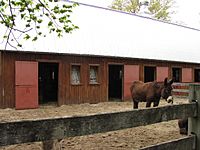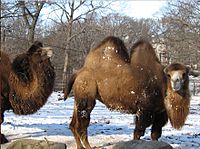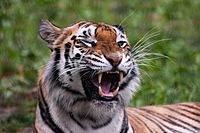Franklin Park Zoo facts for kids
| Date opened | October 4, 1912 |
|---|---|
| Location | Boston, Massachusetts, United States |
| Land area | 72 acres (29 ha) |
| Coordinates | 42°18′19″N 71°05′21″W / 42.3052°N 71.0891°W |
| No. of animals | 1000+ |
| No. of species | 220 |
| Memberships | AZA |
| Major exhibits | 63 exhibits. Highlights are, Nature's Neighborhoods, Farmyard, Outback Trail, Bird's World, Serengeti Crossing, Giraffe Savanna, Tropical Forest, Kalahari Kingdom |
The Franklin Park Zoo is a 72 acres (290,000 m2) zoo located in Boston, Massachusetts. It is currently operated by Zoo New England, which also operates the Stone Zoo in Stoneham, Massachusetts. The zoo is located in the northeast portion of Franklin Park, Boston's largest park and the last component of the city's famed Emerald Necklace.
The zoo was opened to the public in 1912, and managed by the City of Boston until 1958, when the Metropolitan District Commission (MDC) took control. Under the MDC's management, the zoo opened several new exhibits, including Bird's World (c. 1975), the Children's Zoo (1984), and the African Tropical Forest (1989). In 1991, the zoo's management was handed over to the Commonwealth Zoological Corporation (CZS), which also gained management of the Stone Zoo. (In July 1997, the CZS was renamed Zoo New England to "reflect the changing image of both zoos".) The zoo has been accredited by the Association of Zoos and Aquariums (AZA) since 1990.
Contents
History
Frederick Law Olmsted, the original landscape designer of Franklin Park, created plans for a future zoological garden. This plan, however, was to be a naturalistic area for native animals, rather than a traditional zoo. The Franklin Park Zoo officially opened to the public on October 4, 1912 (although most sources say 1913). According to plans by Arthur A. Shurtleff, the new zoo represented a major departure from Olmsted's original plans, and included more exotic animals. However, Shurtleff's design for the zoo was modest and was intended to be in harmony with key elements of the plan, such as a half-mile long grassy mall called "the Greeting", which began at Peabody Circle. The zoo was managed by the Boston Parks Department, was free to all, and extremely popular. An estimated two-million people visited the zoo in 1920.
Unfortunately, the zoo fell into disrepair starting around the time of the Depression and through World War II. In 1958, the Metropolitan District Commission (MDC) took control of the Franklin Park Zoo. The MDC put up fences and gates and started charging admission to the zoo, and areas of the zoo that were difficult to take care of, such as the elephant house and the Bear Dens in Long Crouch Woods, were separated from the zoo property and left to deteriorate. Soon afterward, the zoo received its first professionally trained zoologist to serve as its director, Walter D. Stone. An animal hospital, administrative buildings, and the Children's Zoo (opened in 1962) were also added. In 1970, the Boston Zoological Society assumed some, but not all, management of the zoo, while the state continued to provide funding for the facility.
In 1973, a new $24 million master plan, which would "recommend replacing 'the Greeting' with new zoo exhibits", was formulated to revitalize and expand the facility, and included several new domed pavilions, stressing an African theme. Construction began in 1978, but the process was prolonged due to inadequate funding and political complications.
On July 1, 1984, after extensive renovations, the 3-acre (1.2 ha) Children's Zoo was reopened; around this time it became the zoo's most popular exhibit. After eleven years of construction at a cost of $26 million, the new African Tropical Forest Pavilion opened on September 9, 1989. The zoo was finally accredited by the American Association of Zoological Parks and Aquariums (AAZPA) in 1990. At the time, it was the only zoo in the nation to be run by a state government (besides the Stone Zoo). After accreditation, the zoo's attendance jumped to 200,000. The number of visitors, however, would continue to fluctuate over the next few years.
In 1991, Franklin Park Zoo's management was handed over to the Commonwealth Zoological Corporation (renamed Zoo New England in July 1997). This private, non-profit corporation also took over management of the Stone Zoo, which would reopen in June 1992 after being closed for 18 months due to state budget cuts. In the late 1990s, many new exhibits were built, including Bongo Congo (1997), Outback Trail (1998), and Butterfly Landing (1998). Also at this time, the zoo faced many problems, including multiple budget cuts and dwindling attendance. The zoo is now doing well financially and continues to grow, due to the kindness of many supporters.
The 2011 movie Zookeeper, starring Kevin James, was filmed at the zoo in 2009, and was screened at the zoo on June 28, 2011 as a charity event.
In 2015, one of the zoo's animals, a lion named Christopher who was born in 1993, was humanely euthanized.
In 2019, a white tiger, Luther, was euthanized.
Exhibits
The zoo contains more than 220 species of animals and includes the following main exhibit areas.
The Tropical Forest (known as the African Tropical Forest from 1989 to 1997), a 3-acre (1.2 ha) building roofed by a huge Teflon-coated cloth dome. The building mimics the animals' natural environment with streams, moats, faux-rock structures, hidden fences and barriers, and free-flight birds. The exhibit includes gorillas, bats, dwarf crocodiles, ocelots, ring-tailed lemurs, pottos, Baird's tapirs, vultures, giant anteaters, de brazza's monkeys, cotton-top tamarins and two pygmy hippos. This exhibit was included in the zoo's 1973 master plan, and was originally intended to house only African tropical species; however, more South American and Asian tropical animals began being displayed in the Tropical Forest by the late 1990s. One gorilla named Little Joe escaped his enclosure several times in 2003. He was later separated from the gorilla family, but later returned in 2007. Also in 2007, the zoo's gorilla exhibit was reopened after extensive renovations. As of 2011, a male giant anteater named Jockamo resides in the former warthog enclosure. In spring 2020, A wildlife trade exhibit showcasing artifacts will be displayed in the tropical forest public areas. The crane exhibits outside the tropical forest have been demolished and will be renovated to house western lowland gorilla and colobus. The new multi-habitat will be a rotational mixed-species exhibits between the two. The habitats will be netted over and have various viewing through glass, mesh and a training wall.
Serengeti Crossing (known as Bongo Congo from 1997 to c. 2003), a 4-acre (1.6 ha) grasslands exhibit with ostriches, blue wildebeests, Grant's zebras, and warthogs. The exhibit first opened in 1997, making it one of the first new exhibits to open at the zoo since the opening of the African Tropical Forest in 1989. Reconfigured to 1.25 acres in 2018, adding a new path and entry garden. The observation decks that once overlooked this exhibit have been collected. A new warthog boar has been brought in for female Kanunu to mate with. A pair of Hatman Zebra have joined the Zoo.
Kalahari Kingdom, a large Africa themed area housing two male African lion brothers. Visitors can view them through a replica of a land rover "crashed" into the exhibit, glass, or from over a moat. The opening of this exhibit in 1997 marked the first time lions had been exhibited at the zoo since the old Lion House was closed in the early 1970s. Other animals included are male and female Siberian tigers and Bengal tigers as well as some red river hogs, bongo, kori bustards, domestic Bactrian camels and African spurred tortoises. A new, male Red River Hog was brought in for breeding purposes with the resident female River Hog.
Outback Trail, where visitors can view kangaroos, cockatoos, emus, North Island brown kiwis and Tawny frogmouth. This exhibit opened around 1998, the same year the Butterfly Landing exhibit first opened. A seasonal budgerigar aviary offers opportunities to feed and be amongst the budgerigar.
Giraffe Savannah, opened in 1999, is a large area containing Masai giraffes, and Grevy's zebras can be found coexisting with them. There’s also wattled cranes nearby.
Bird's World, a large building with an Orient-themed exterior containing dozens of bird species in four different environments: swamp, rainforest, desert, and wetlands. Outside, there is a large flight cage for Andean condors and Steller's sea eagles, an aviary for kookaburras, Indian peacocks, and kea, with more free-flight birds, and a waterfowl pond. A three-year-old male Steller's Sea Eagle named O-washi debuted in May 2018. This building originally opened in 1912 (the same year the zoo itself opened to the public) and was renovated around the mid-1970s to exhibit birds in more naturalistic environments. In late 2018 a storm damaged the Chilean Flamingo exhibit resulting in the flock being moved on-show at the Tropical Forest and the exhibit being collected. In 2020, the former African-themed exhibit for the Greater flamingo exhibit and the rainforest-themed exhibit for the Chilean Flamingo is joined with an Asian-themed exhibit with the white-naped crane. In the Riverbank exhibit that once held the Tawny Frogmouth enclosure now houses a female and a male Green Iguana with the tawny frogmouth. Swifty, the Spurred Tortoise winters in the desert with finches.
Butterfly Landing, a seasonal exhibit containing over 1,000 butterflies in free flight. This large outdoor "tent" also has streams and a waterfall surrounded by numerous plant species. The exhibit first opened in 1997.
Nature's Neighborhood A Children's Zoo that is a three-acre complex which includes a new, walk-through aviary with assorted birds, prairie dogs, red pandas, turtles, and reeve's muntjac. There is also Franklin Farm, a barn with paddocks for livestock and an interaction area for goats with various outbuildings. The animals include Poitou Donkey, pony, llama, barn owl, chicken, Nigerian Dwarf goat, Guinea hog and Welsh Mountain sheep. In 2020, a group of Java green peacocks joined the exhibit.
There is also a spotted hyena exhibit, outside the Tropical Forest, that is not part of any major area. It first opened in 2014. It housed an African wild dog. Also, with the demolition of the exhibits for Siberian cranes, and white-naped cranes in favour of Gorillas, the cranes have been moved.
Attendance
The zoo's attendance has been rising in the last few years, but has never equalled the numbers when it was free to all. It hopes in the future to have one million visitors to qualify as a regional zoo.
- 1920: 2 million visitors (when the zoo was free)
- 1984: 100,000 visitors (after the renovated Children's Zoo opened)
- 1988: 35,000 visitors
- 1990: 200,000 visitors (after the African Tropical Forest opened in 1989)
- 1993: 132,832 visitors
- 1994: 153,310 visitors
- 1996: 130,000 visitors
- 1997: 130,000 visitors
- 1998: 240,000 visitors
- 2006: 266,997 visitors
- 2007: 308,166 visitors
- 2008: 326,543 visitors
- 2009: 342,313 visitors
- 2014: 418,167 visitors
- 2016: 353,891 visitors
Images for kids







